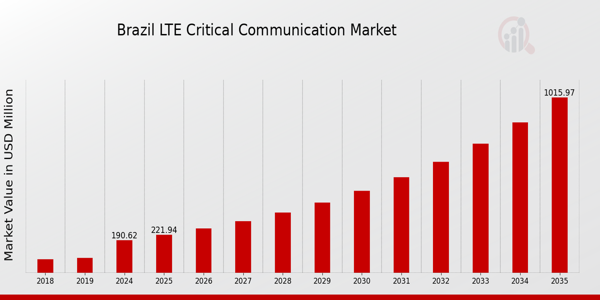Brazil LTE Critical Communication Market Overview
As per MRFR analysis, the Brazil LTE Critical Communication Market Size was estimated at 166.74 (USD Million) in 2023.The Brazil LTE Critical Communication Market Industry is expected to grow from 190.62(USD Million) in 2024 to 1,016 (USD Million) by 2035. The Brazil LTE Critical Communication Market CAGR (growth rate) is expected to be around 16.43% during the forecast period (2025 - 2035)
Key Brazil LTE Critical Communication Market Trends Highlighted
The Brazil LTE Critical Communication Market is experiencing substantial trends that are being driven by the growing demand for dependable communication during critical operations and emergencies. Brazilian government initiatives prioritize the improvement of public safety and emergency response capabilities. This emphasis on the enhancement of communication infrastructure is particularly important in urban areas such as Rio de Janeiro and São Paulo, where urban safety is a top priority. Furthermore, there is a discernible trend toward the implementation of advanced LTE technologies in critical communication, which facilitates real-time data exchange and seamless connectivity among first responders.
The market is experiencing a growth in opportunities as Brazil continues to modernize its telecommunications infrastructure. Businesses have the opportunity to investigate potential collaborations with governmental agencies by investing in public safety networks and implementing the National Internet of Things (IoT) strategy. Innovative solutions that can integrate LTE communication systems in varied environments are also being facilitated by the recent drive for private-public partnerships to enhance broadband access in remote areas. Brazil has recently witnessed an increase in the incorporation of technological advancements, including artificial intelligence and data analytics, into its critical communication frameworks.
This trend not only enhances decision-making capabilities in emergencies but also improves operational efficiency. The market is also significantly influenced by the increasing emphasis on cybersecurity, as the protection of communication networks becomes increasingly critical in the presence of potential threats. In general, the Brazil LTE Critical Communication Market is adjusting rapidly to accommodate the changing requirements of public safety and critical infrastructure, thereby establishing a strong foundation for future expansion.

Source: Primary Research, Secondary Research, MRFR Database and Analyst Review
Brazil LTE Critical Communication Market Drivers
Growing Need for Public Safety Communications
The Brazil LTE Critical Communication Market Industry is significantly driven by the increasing need for public safety communications. In a report from the Brazilian Ministry of Justice, it was stated that crime rates in urban areas have surged, with a 20% increase in violent incidents reported over the last five years. This surge is pushing government and local agencies to prioritize the establishment of uninterrupted communication networks capable of handling emergencies.
Organizations such as the National Telecommunications Agency (ANATEL) have endorsed the use of Long-Term Evolution (LTE) technology for critical communication as being essential for enhancing operational efficiency. Furthermore, the government is supporting initiatives to integrate LTE communications in public safety frameworks, which is bolstering investments in the Brazil LTE Critical Communication Market.
Advancements in Technology and Infrastructure
Technologi Size, Share Report Forecast 2035cal advancements are rapidly influencing the Brazil LTE Critical Communication Market Industry. According to the Brazilian Institute of Geography and Statistics, the country has observed substantial growth in its telecommunications infrastructure, with an increase of approximately 15% in 4G LTE network coverage over the past two years.
Established companies such as Vivo and Claro are actively expanding their LTE services to ensure robust communication capabilities for critical services.The integration of new technologies, including Internet of Things (IoT) devices within critical communications, is expected to further enhance reliability and performance. This robust technological foundation is vital for improving response times and situational awareness during emergencies.
Government Investments in Emergency Services
Government initiatives and investments aimed at enhancing public safety services are a significant driver for the Brazil LTE Critical Communication Market Industry. The Brazilian government's commitment was highlighted when it allocated approximately $150 million towards modernizing the emergency response framework through advanced communication systems.
This initiative is part of Brazil's National Plan for Public Security and aims to enhance the capabilities of various emergency services, including fire departments and the police.By promoting the development of LTE networks tailored for these services, the government is creating a conducive environment for market growth while ensuring citizen safety.
Increasing Adoption of Mobile Device Usage by Emergency Personnel
The increase in mobile device usage among emergency personnel is another critical driver for the Brazil LTE Critical Communication Market Industry. A survey conducted by the Brazilian Association of Telecommunications (AbrTelecom) indicated that approximately 80% of emergency responders are now using smartphones and tablets equipped with LTE capabilities. This shift signifies an evolution in how emergencies are managed and reported.
With organizations like the Brazilian Fire Brigade leveraging these technologies, there is a growing need for reliable and high-speed communication channels.This trend's implications for the Brazil LTE Critical Communication Market are substantial, as more investment is required to facilitate the unique needs of emergency personnel.
Brazil LTE Critical Communication Market Segment Insights
LTE Critical Communication Market Component Insights
The Brazil LTE Critical Communication Market is poised for significant advancements over the coming years, primarily driven by the critical need for robust and reliable communication systems in various sectors such as public safety, transportation, and emergency services. Within this market, the Component segment plays a crucial role, encompassing essential elements including Hardware, Software, and Solutions that collectively enhance the operational efficiency of critical communications. Hardware finds immense significance as it encompasses the physical infrastructure necessary for establishing LTE networks, which are vital for ensuring seamless connectivity and communication among first responders and other key stakeholders in critical situations.
The importance of Software in this segment cannot be understated, as it provides the necessary applications and systems that facilitate data management, real-time communication, and the integration of various communication tools, ensuring that personnel remain informed and coordinated during emergencies. Solutions within this segment focus on tailored packages that combine Hardware and Software to meet the specific requirements of various industries, enhancing functionality and ensuring compliance with local regulations in Brazil. As Brazil progresses in its efforts to modernize and enhance its communication infrastructure, these components are essential for driving the effective use of LTE technology in critical communication scenarios, particularly in urban areas where rapid response and connectivity are crucial.
Additionally, with a strong emphasis on public safety and improvements in emergency response protocols, the Brazil LTE Critical Communication Market is shifting towards more integrated and advanced solutions that help streamline communication and enhance situational awareness for users, thereby reinforcing the importance of this segment in the overall market landscape. This sector's growth is largely propelled by increasing investments from the Brazilian government in public safety initiatives, as well as a rising demand from industries seeking to implement more efficient communication systems.As technology evolves, the demand for sophisticated Hardware and innovative Software solutions will likely continue to rise, stimulating further enhancements in critical communication networks and ensuring that Brazil remains resilient to various challenges.
The Brazilian market is also witnessing an ongoing trend where collaborations between technology providers and government bodies are instrumental in developing state-of-the-art solutions that cater to the unique communication needs of the country, ultimately strengthening the overall infrastructure and effectiveness of LTE critical communication.Through these developments, there lies a remarkable opportunity for stakeholders to innovate and contribute to the market, establishing Brazil as a frontrunner in adopting advanced LTE critical communication technologies across diverse sectors.

Source: Primary Research, Secondary Research, MRFR Database and Analyst Review
LTE Critical Communication Market Technology Insights
The Brazil LTE Critical Communication Market's Technology segment is characterized by its diverse range of solutions designed to enhance communication efficiency and reliability in critical situations. Digital Mobile Radio is pivotal for public safety communications, offering robust features that cater to emergency services, thus ensuring uninterrupted connectivity during crises. Similarly, LTE-Advanced distinguishes itself by delivering superior data transfer rates and network reliability, which are essential for real-time monitoring and coordination among various sectors such as healthcare and transportation.Terrestrial Trunked Radio serves a vital role in enabling localized communication among public safety agencies, enhancing operational effectiveness and responsiveness.
P25 technology is increasingly important as it meets the needs of emergency responders through its interoperable communication capabilities, fostering collaboration and information sharing. This segment is further driven by technological advancements and an increasing focus on safer urban development initiatives, making the Brazil LTE Critical Communication Market a significant player in the broader communications landscape.Continued investment in these technologies is expected to strengthen Brazil’s infrastructure overall, ensuring preparedness and resilience in the face of emerging challenges.
LTE Critical Communication Market End User Insights
The Brazil LTE Critical Communication Market showcases a diverse range of end users that are pivotal in shaping the landscape of this sector. The IT and Telecommunication sector plays a crucial role in facilitating robust communication networks, integral for seamless data transfer and connectivity across various operations. Government and Defense utilize critical communication platforms for improved coordination and security, especially during emergencies and national security operations. The Aerospace industry benefits from enhanced communication technologies that support rigorous safety standards and operational efficiency.Transportation systems rely heavily on critical communication for real-time tracking and safety protocols, ensuring efficient logistics and passenger safety.
Utilities rely on reliable communication channels to manage grid operations and service delivery effectively. The Oil and Gas sector is also significant, where real-time monitoring and communication can enhance operational safety and efficiency in remote locations. Collectively, these sectors are driving the demand for advanced LTE solutions, reflecting the crucial need for reliable, efficient communication systems across Brazil's economy.The segmentation highlights the multifaceted needs each sector faces, thereby fostering innovations and investments to optimize communication infrastructure in these vital industries.
Brazil LTE Critical Communication Market Key Players and Competitive Insights
The Brazil LTE Critical Communication Market has become increasingly competitive as stakeholders recognize the importance of robust and reliable communication systems for mission-critical applications, including public safety, emergency response, and industrial operations. The demand for enhanced connectivity driven by rising security concerns and the need for efficient communication networks is propelling growth within the sector. As countries invest in next-generation LTE infrastructure to support critical communications, various players are positioning themselves strategically to leverage the opportunities in this rapidly evolving market. The competitive landscape is characterized by continual innovations, partnerships, and the development of customized solutions that cater to the unique needs of Brazilian enterprises and governmental agencies.NEC has established a significant presence in the Brazil LTE Critical Communication Market through its expertise in developing advanced telecommunications technologies.
The company is recognized for its ability to deliver reliable and high-performance solutions that facilitate seamless communication in critical environments. NEC's strengths lie in its comprehensive suite of offerings, including integrated communication and collaboration platforms that enhance situational awareness for public safety agencies. The company's commitment to research and development allows it to stay at the forefront of technology, which is pivotal in fostering customer trust and satisfaction. Its local partnerships and collaborations with Brazilian governmental entities further strengthen NEC's position, enabling the company to address the specific challenges faced by the region’s critical communication sector effectively.ZTE is another key player in the Brazil LTE Critical Communication Market, contributing significantly with its innovative communication solutions. The company has a diverse portfolio of products and services tailored to meet the demands of critical communications, such as LTE infrastructure, terminals, and private network solutions.
ZTE’s robust market presence in Brazil is bolstered by its strategic alliances with local operators and government agencies, establishing itself as a trusted partner for enhancing communication capabilities in critical situations. The company’s focus on advanced network technologies, including software-defined networking and cloud-based solutions, provides them with a competitive edge. ZTE's strengths include its ability to deliver scalable and flexible solutions that can be customized according to customer needs. The company has also pursued mergers and acquisitions to strengthen its position in the Brazilian market, driving innovation and expanding its product offerings, which positions them favorably for future growth in this competitive landscape.
Key Companies in the Brazil LTE Critical Communication Market Include
- NEC
- ZTE
- Motorola Solutions
- Sepura
- Avigilon
- Cisco
- Huawei
- Samsung
- Cisco Systems
- Nokia
- Hytera
- Ericsson
Brazil LTE Critical Communication Market Industry Developments
Motorola Solutions demonstrated its integrated mission-critical technology ecosystem at LAAD 2023 in Rio de Janeiro in April 2023. AI is integrated with voice, video, data, and analytics in the ecosystem to offer public safety and defense personnel a comprehensive 360° perspective on incidents as they occur. Brazil's public safety agencies benefit from this integrated approach, which improves situational awareness and communication. Motorola Solutions announced in June 2025 that it had been chosen by the Band Administration Entity (EAF), an organization established by the Brazilian Telecommunications Agency (Anatel), to implement a new federal mission-critical communications solution.
The objective of this solution is to improve the protection of Brazil's communities by integrating multiple existing land mobile radio (LMR) systems and introducing new mission-critical Push-to-X (MCX) broadband services. This will enhance interagency interoperability and access to data applications. ZTE effectively deployed the ZTE Smart Cloud Platform (SCP) in Brazil in April 2023 through a partnership with Multi PRO, a subsidiary of Grupo Multi Company. The objective of this deployment is to improve cloud-based communication services, thereby facilitating the development of essential communication infrastructure in the region.
Brazil LTE Critical Communication Market Segmentation Insights
LTE Critical Communication Market Component Outlook
-
- Hardware
- Software
- Solution
LTE Critical Communication Market Technology Outlook
-
- Digital Mobile Radio
- LTE-Advanced
- Terrestrial Trunked Radio
- P25
LTE Critical Communication Market End User Outlook
-
- IT & Telecommunication
- Government & Defense
- Aerospace
- Transportation
- Utilities
- Oil & Gas
| Report Attribute/Metric Source: |
Details |
| MARKET SIZE 2023 |
166.74(USD Million) |
| MARKET SIZE 2024 |
190.62(USD Million) |
| MARKET SIZE 2035 |
1016.0(USD Million) |
| COMPOUND ANNUAL GROWTH RATE (CAGR) |
16.43% (2025 - 2035) |
| REPORT COVERAGE |
Revenue Forecast, Competitive Landscape, Growth Factors, and Trends |
| BASE YEAR |
2024 |
| MARKET FORECAST PERIOD |
2025 - 2035 |
| HISTORICAL DATA |
2019 - 2024 |
| MARKET FORECAST UNITS |
USD Million |
| KEY COMPANIES PROFILED |
NEC, ZTE, Motorola Solutions, Sepura, Avigilon, Cisco, Huawei, Samsung, Cisco Systems, Tait Communications, Nokia, Hytera, AlcatelLucent, Ericsson |
| SEGMENTS COVERED |
Component, Technology, End User |
| KEY MARKET OPPORTUNITIES |
Public safety network upgrades, Smart city initiatives, Emergency service enhancements, Industrial IoT integration, Expanding private LTE networks |
| KEY MARKET DYNAMICS |
growing public safety demand, increasing government investments, technological advancements in LTE, rising cybersecurity concerns, need for reliable communication |
| COUNTRIES COVERED |
Brazil |
Frequently Asked Questions (FAQ):
The Brazil LTE Critical Communication Market is expected to be valued at 190.62 million USD in 2024.
The market is projected to reach a value of 1016.0 million USD by 2035.
The expected compound annual growth rate for the market during this period is 16.43%.
The hardware segment had the highest value, estimated at 70.0 million USD in 2024.
The software component is expected to reach a market size of 250.0 million USD by 2035.
Key players include NEC, ZTE, Motorola Solutions, and Cisco, among others.
The solution segment is projected to be valued at 386.0 million USD in 2035.
Emerging trends and technological advancements offer significant growth opportunities in this market.
Increasing demand for critical communication solutions is likely to heighten competition among major players.
The market is expected to grow at a CAGR of 16.43% from 2025 to 2035.
















